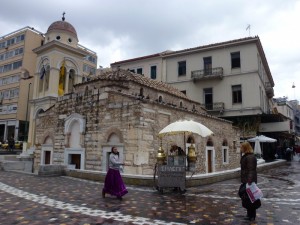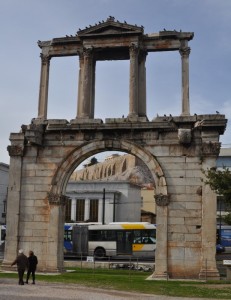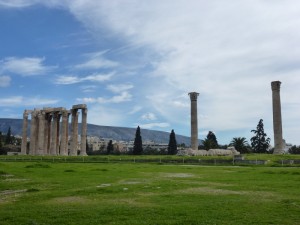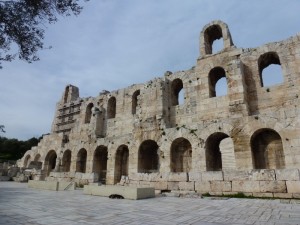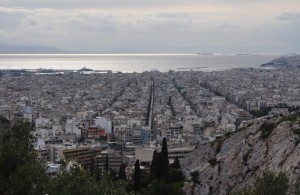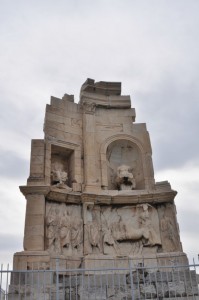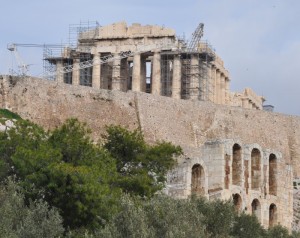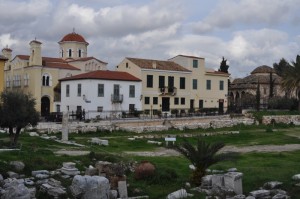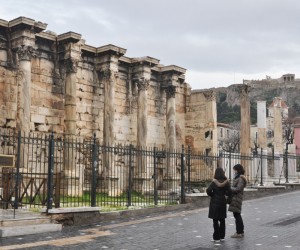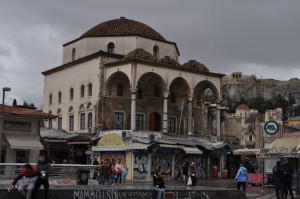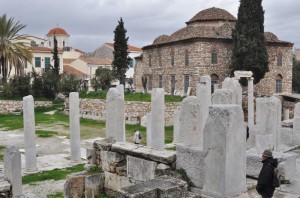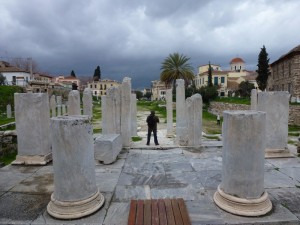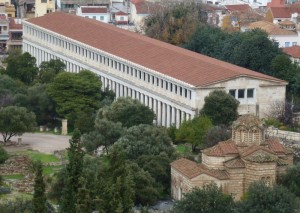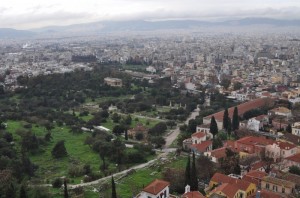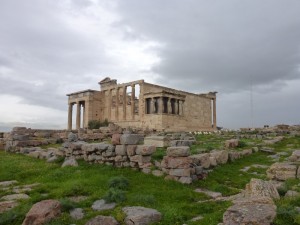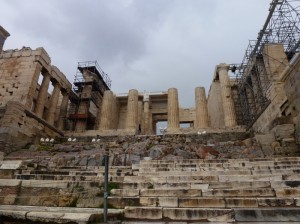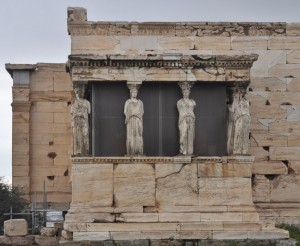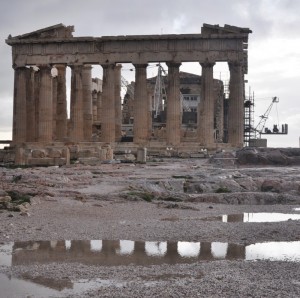Neither Greece nor Israel was not on my original itinerary. While in Malta, I discovered Air Malta flies to Athens and the fare is reasonable. Israel which has always been on my wish-list is only two hours from Athens. Bingo!
Background
Greece, officially the Hellenic Republic, has a long and rich history. The earliest evidence of human presence in the Balkans, dated to 270,000 BC, is found in the Petralona cave in the northern province of Macedonia. Neolithic settlements in Greece dating from the 7th millennium BC are the oldest in Europe. Ancient Greece is generally considered the cradle of Western civilization and birthplace of democracy, Western philosophy, the Olympic Games (the first one in 776 BC), Western literature, political science, major scientific and mathematical principles and Western drama.
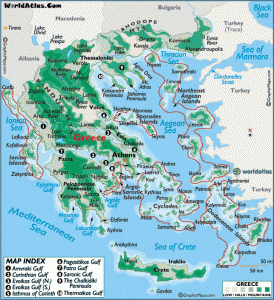 The first unified Greek state in the history of Greece came when Phillip II, King of Macedon from 359 to 336 BC, was elected leader of the League of Corinth. The golden era came when Alexander III assumed leadership of the League in 336 BC. Alexander the Great invaded the Persian Empire in 334 BC and marched on Susa and Persepolis in 330 BC. The Greek Empire stretched from Greece in the west to Pakistan in the east and Egypt in the south. Sudden death of Alexander III in 323 BC caused collapse of the empire. Nonetheless, Hellenistic civilization and the Greek language had prospered in the conquered territories for centuries.
The first unified Greek state in the history of Greece came when Phillip II, King of Macedon from 359 to 336 BC, was elected leader of the League of Corinth. The golden era came when Alexander III assumed leadership of the League in 336 BC. Alexander the Great invaded the Persian Empire in 334 BC and marched on Susa and Persepolis in 330 BC. The Greek Empire stretched from Greece in the west to Pakistan in the east and Egypt in the south. Sudden death of Alexander III in 323 BC caused collapse of the empire. Nonetheless, Hellenistic civilization and the Greek language had prospered in the conquered territories for centuries.
Greece was annexed into the Roman Empire by Augustus in 27 BC and constituted as the senatorial province of Achaea. It then came under the Byzantine Empire. In the 14th century much of the Greek peninsula was lost to the Serbs. With the rise of the Ottomans and the fall of Constantinople in 1453, Greece finally became part of the Ottoman Empire in 1460. Struggles for independence began when a secret organization called the Filiki Eteria was established in 1814 with the aim of liberating Greece. A nascent Greek state was finally recognized under the London Protocol in 1830.
Since then, Greece has gone through prolong period of political instability, brutality, turbulence and tragedy. It had two wars with the Turks (the Greco-Turkish War of 1897 and 1919 -22) and its relationship with Turkey reached another crisis when the latter invaded Cyprus in July 1974. The coup d’état in 1936 saw the rise of Ioannis Metaxas who headed a dictatorial regime known as the 4th August Regime. After liberation in 1945, Greece experienced a bitter civil war between communist and anticommunist forces for the next 30 years. The brutal suppression of the Athens Polytechnic uprising shocked the nation and a counter-coup established Brigadier Dimitrios Ioannidis as dictator in 1967.
Greece with an area of 131,957 square kilometres and a population of about 11 million (2011 census) became the tenth member of the European Communities (subsequently subsumed by the European Union) on January 1, 1981.
The EU membership has ushered in a period of economic growth. Greece adopted the Euro in 2001 and hosted the 2004 Olympic Games. It has been hit hard by the global financial crisis which has attributed to the sovereign debt crisis. Since 2010, there has been widespread social discontent and unrest against the Government’s austerity measures which has led to violent protests. The Greek Government has been beset by political instability in addition to financial, economic and debt problems. GDP (PPP) and per capita for 2012 was estimated to be US$ 280.8billion and US$25,000 respectively.
February 11 Monday: Malta – Athens
I had a pleasant flight and arrived in Athens after 7pm. The new airport is a nice surprise. The new metro link from the airport to the city costing € 8 took me to Syntagma Square in just 45mintes. As I missed a train by a few minutes, I had to wait almost 30 minutes for the next one at 8:22pm. I arrived at my hotel in Plaka after 9:30pm. There were few tourists and the place looked empty and deserted!
I booked a room online for €34 in a modest hotel. I decided to move as there is no attached toilet and bathroom even for that price. I found a decent single room (en-suite) in the Student & Travellers Inn nearby for €26.
February 12 Tuesday: Athens
I planned to spend a week in Greece after my trip to Israel i.e. from February 25 to March 5. I also had to decide how to travel to Romania. Should I go by road or by air? I do not want to spend 24 hours in the bus. So I must fly. After some difficulties, I managed to book a flight to Bucharest in the evening on March 5.
The next job was to decide which islands to visit and then book ferries and hotels. As the websites of ferry companies are not user-friendly, I decided to book the ferry tickets with a local agent. I went to two and it had been a frustrating experience. Both agents were run by men in their 50s. They are slow (by my standard) and one is not able to use the computer proficiently! I spent over two hours before the agent sorted out my ferry and plane tickets and booked seven nights’ accommodation on Patmos, Kos and Rhodes from February 26 to March 5 for € 400. It is not cheap at all. (Normally I book the hotel and tickets online myself and try to get the best price. This time I was lazy and wished to find out the service of local travel agents)
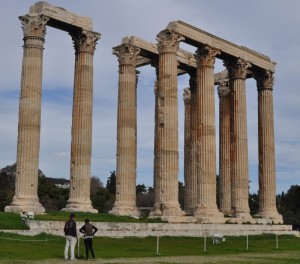 |
It was almost 1pm before I could set off on city tour. I began at the Hadrian’s Arch (131 AD) and my first stop was the Olympieion which includes the sanctuary (temple) of Olympian Zeus (6th century BC), Roman baths, Roman houses and a section of the ancient city’s fortification wall. The temple was completed in 131 AD by Emperor Hadrian and was among one of the biggest in antiquity measuring 110m in length and approximately 44m in width with three rows of eight columns at the narrow sides and two rows of twenty columns at its long side.
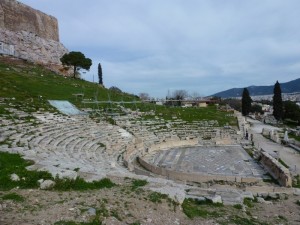 |
The weather was fantastic with blue sky and light wind. I walked along Dionysou Areopaghitou Street and arrived at the ancient Theatre of Dionysos at the southern slope of the Acropolis. It is the world’s most ancient theatre with a capacity of 17,000. The auditorium and the proscenium were reconstructed using marble in the 4th century BC. Unfortunately all archaeological sites except the Acropolis close at 3pm. The attendants drove me out around 2:45pm.
My third stop was the Philopappou Hill affording a splendid 360-degree of Athens. On top of the hill stands the Philopappus Monument built by Athenians in the 2nd century BC in honour of the benefactor, ruler of Syria, Gaius Julius Antiochus.
I could have gone to the Acropolis as it would be open for another hour. I did not want to rush and decided to visit it the following day. (This was a big mistake!) I spent the rest of the afternoon strolling in Plaka and taking pictures.
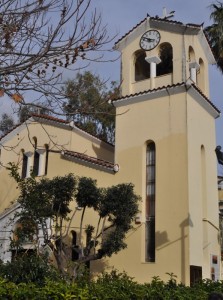 |
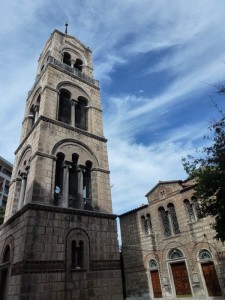 |
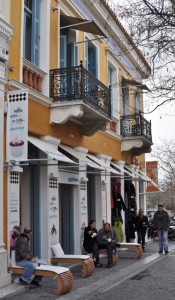 |
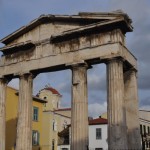 |
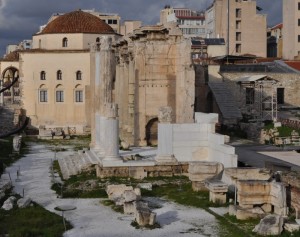 |
February 13 Wednesday: Athens
The weather forecast for the day was bad. But no one could have imaged the torrential rain, thunder storm and lightning would last from about 11 am to 2pm.
I began my tour at the foothill of the Acropolis. The first stop was the Hadrian Library (132 AD) a rectangular building measuring 122m by 82m. There were a few raindrops.
The next stop was the Roman Agora. Built between 19 and 11 BC, it is about 100m to the east of the Ancient Agora. The more interesting structures/features still standing include the Gate of Athena Archegetis, Kyrristus’ Clock (also known as Tower of Winds), Vespasianae (public lavatories) and Fetiye Gami or Mosque of the Conqueror(1456). It started to rain heavily and I had to put on my water proof jacket.
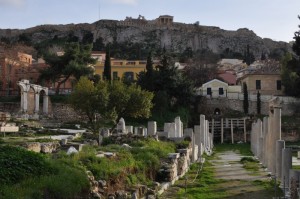 |
The third stop was the Ancient Agora, a large square on the northwest slope of the Acropolis. It acquired its final form in the 2nd century AD. Agora was an important political, cultural, religious and commercial centre. The restored Stoa is now the Museum of the Athenian Agora housing the finds from the excavations at the site. I find the most interesting exhibits are those connected with the functions of Athenian democracy dating back to the Classical and Late Classical Period. They include a clay klepsydra-water clock for timing speeches, ostracism ostraka incised with the names of ancient politicians, jurors’ ballots etc.
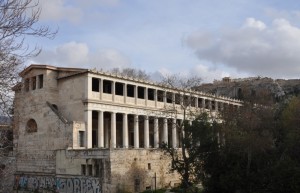 |
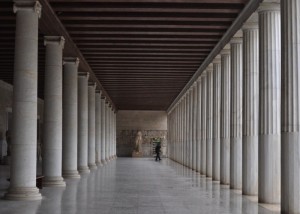 |
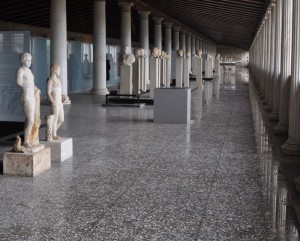 |
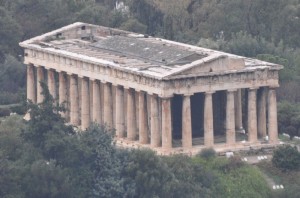 |
The sky was pitched dark and it started to rain cats and dogs. The thunder storm and lightning were frightening. I rushed to the Museum just in time. When the sky looked a bit brighter an hour later, I ventured out. By the time I reached the Temple of Hephaistos located at the western perimeter of the Agora, it rained heavily again. The temple built in 460-415 BC is the best-preserved temple of antiquity.
The weather was so bad that I decided to find shelter in a restaurant opposite the Agora. The starter costing €7 was a disaster: the mussels were tiny and the sauce was too salty! The main dish with pork and rice is nice and filling for a cold wet day.
It was still raining. I returned to the hotel to put on dry clothes. At 3:30pm I suddenly saw sunlight coming through clouds. I rushed out and took a shortcut to the Acropolis. With my pass, I was able to get in though I only had 40 minutes. Nevertheless, it was virtually empty with only a handful of visitors!
The Temple of the Athena Victory (Wingless Victory) built circa 420 BC in commemorate of the victory of the Greeks against the Persians.
The Parthenon dedicated to Goddess Athena is an architectural masterpiece. It was built with Pentelic marble from 447-432BC. It is a Doric peripteral temple with 8 columns on the front and the back and 17 columns on each side.
.The Erechtheion (420-406 BC) built at the most holy site of the Acropolis where goddess Athena planted the olive tree, her sacred symbol.
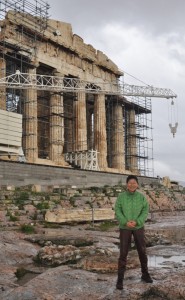 |
 |
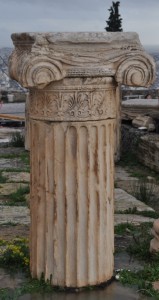 |
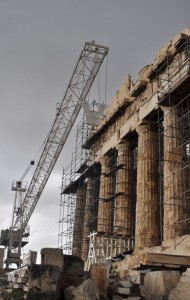 |
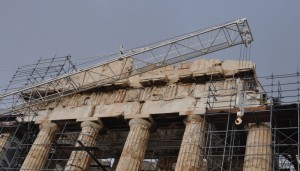 |
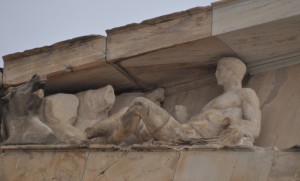 |
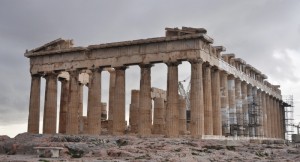 |
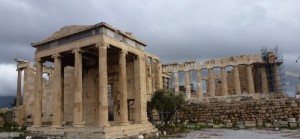 |
February 14 Athens- Tel Aviv
I prefer the bus to metro: I see more and have a better feel about the place. I took a bus from the Syntagma Square at 6:40am. The fare is only €5 and I arrived at the airport an hour later. My plane took off on time at 10:25am and I arrived in Tel Aviv, Israel at 12:30pm.
Remarks
Athens on my first visit in 1980 was wrapped in smog. Things were slow and chaotic. People were poor by European standards. People reminded me to avoid Plaka which was not safe. When I visited it again in late 1980s, I was shocked by the traffic congestion.
Athens today has changed and looks greener and smarter. The 2004 Olympic Games has given the city a facelift. The upgrading of the infrastructures and the airport is remarkable: the new metro lines and improved road network have transformed the city and improved the city landscape.
I am concerned about several developments. First I am horrified by the pace of urbanization resulting in a sprawling city.
Second, the cost of living has gone up a lot. I had a small bowl of yogurt in a self-service shop in Plaka for €4.5: it is the most expensive cup of yogurt I have ever had! I had a small portion of roast lamb in a local restaurant for €14. Greece is no longer a cheap holiday destination. This would affect its appeal unless it can offer a unique product or experience.
Third, the service offered by the two travel agents I have encountered is far from satisfactory in terms of price, quality and understanding of customers’ expectations. The agent explains to me that local agents have to charge more for hotels because of the 23% tax imposed by the Greek Government on hotel accommodation. But if it is booked online through foreign companies, no tax is required. This sounds incredible. The Greek Government needs to identify all possible means to get more revenue. This may



